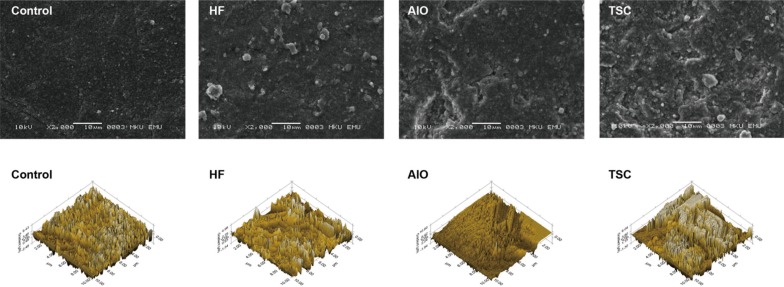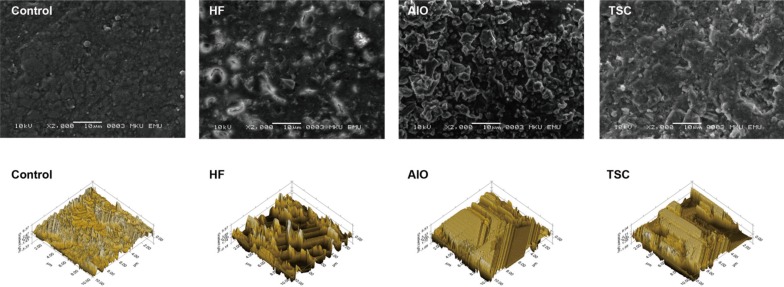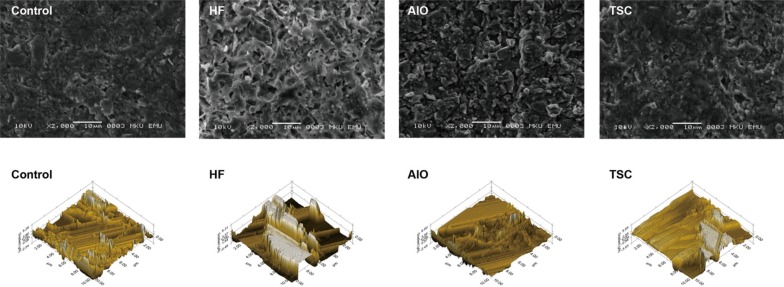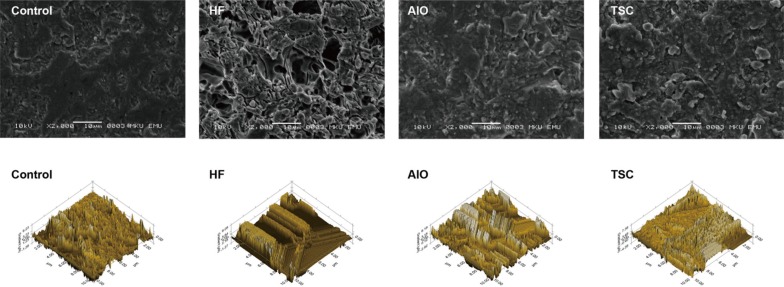J Adv Prosthodont.
2020 Feb;12(1):22-32. 10.4047/jap.2020.12.1.22.
Effect of surface treatments and universal adhesive application on the microshear bond strength of CAD/CAM materials
- Affiliations
-
- 1Department of Restorative Dentistry, Faculty of Dentistry, Altınbaş University, Istanbul, Turkey. soner.s@hotmail.com
- 2Department of Pediatric Dentistry, Faculty of Dentistry, Altınbaş University, Istanbul, Turkey.
- 3Department of Restorative Dentistry, Faculty of Dentistry, Hatay Mustafa Kemal University, Hatay, Turkey.
- 4Department of Prosthodontics, Faculty of Dentistry, Altınbaş University, Istanbul, Turkey.
- 5Department of Restorative Dentistry, Faculty of Dentistry, Istanbul Medipol University, Istanbul, Turkey.
- KMID: 2470794
- DOI: http://doi.org/10.4047/jap.2020.12.1.22
Abstract
- PURPOSE
The aim of this study was to evaluate the microshear bond strength (µSBS) of four computer-aided design/computer-aided manufacturing (CAD/CAM) blocks repaired with composite resin using three different surface treatment protocols.
MATERIALS AND METHODS
Four different CAD/CAM blocks were used in this study: (1) flexible hybrid ceramic (FHC), (2) resin nanoceramic (RNC), (c) polymer infiltrated ceramic network (PICN) and (4) feldspar ceramic (FC). All groups were further divided into four subgroups according to surface treatment: control, hydrofluoric acid etching (HF), air-borne particle abrasion with aluminum oxide (AlO), and tribochemical silica coating (TSC). After surface treatments, silane was applied to half of the specimens. Then, a silane-containing universal adhesive was applied, and specimens were repaired with a composite, Next, μSBS test was performed. Additional specimens were examined with a contact profilometer and scanning electron microscopy. The data were analyzed with ANOVA and Tukey tests.
RESULTS
The findings revealed that silane application yielded higher µSBS values (P<.05). All surface treatments were showed a significant increase in µSBS values compared to the control (P<.05). For FHC and RNC, the most influential treatments were AlO and TSC (P<.05).
CONCLUSION
Surface treatment is mandatory when the silane is not preferred, but the best bond strength values were obtained with the combination of surface treatment and silane application. HF provides improved bond strength when the ceramic content of material increases, whereas AlO and TSC gives improved bond strength when the composite content of material increases.
MeSH Terms
Figure
Reference
-
1. Coldea A, Swain MV, Thiel N. Mechanical properties of polymer-infiltrated-ceramic-network materials. Dent Mater. 2013; 29:419–426. PMID: 23410552.
Article2. Conrad HJ, Seong WJ, Pesun IJ. Current ceramic materials and systems with clinical recommendations: a systematic review. J Prosthet Dent. 2007; 98:389–404. PMID: 18021828.
Article3. Ruse ND, Sadoun MJ. Resin-composite blocks for dental CAD/CAM applications. J Dent Res. 2014; 93:1232–1234. PMID: 25344335.
Article4. Vichi A, Carrabba M, Paravina R, Ferrari M. Translucency of ceramic materials for CEREC CAD/CAM system. J Esthet Restor Dent. 2014; 26:224–231. PMID: 24974858.
Article5. Della Bona A, Nogueira AD, Pecho OE. Optical properties of CAD-CAM ceramic systems. J Dent. 2014; 42:1202–1209. PMID: 25019364.
Article6. Coldea A, Swain MV, Thiel N. In-vitro strength degradation of dental ceramics and novel PICN material by sharp indentation. J Mech Behav Biomed Mater. 2013; 26:34–42. PMID: 23807311.
Article7. Della Bona A, Corazza PH, Zhang Y. Characterization of a polymer-infiltrated ceramic-network material. Dent Mater. 2014; 30:564–569. PMID: 24656471.
Article8. Schepke U, Meijer HJ, Vermeulen KM, Raghoebar GM, Cune MS. Clinical bonding of resin nano ceramic restorations to zirconia abutments: A case series within a randomized clinical trial. Clin Implant Dent Relat Res. 2016; 18:984–992. PMID: 26456161.
Article9. Bonfante EA, Suzuki M, Lorenzoni FC, Sena LA, Hirata R, Bonfante G, Coelho PG. Probability of survival of implant-supported metal ceramic and CAD/CAM resin nanoceramic crowns. Dent Mater. 2015; 31:e168–e177. PMID: 26074312.
Article10. Roggendorf MJ, Kunzi B, Ebert J, Roggendorf HC, Frankenberger R, Reich SM. Seven-year clinical performance of CEREC-2 all-ceramic CAD/CAM restorations placed within deeply destroyed teeth. Clin Oral Investig. 2012; 16:1413–1424.
Article11. Frankenberger R, Taschner M, Garcia-Godoy F, Petschelt A, Krämer N. Leucite-reinforced glass ceramic inlays and onlays after 12 years. J Adhes Dent. 2008; 10:393–398. PMID: 19058686.12. Wady AF, Paleari AG, Queiroz TP, Margonar R. Repair technique for fractured implant-supported metal-ceramic restorations: a clinical report. J Oral Implantol. 2014; 40:589–592. PMID: 25295889.
Article13. Neis CA, Albuquerque NL, Albuquerque Ide S, Gomes EA, Souza-Filho CB, Feitosa VP, Spazzin AO, Bacchi A. Surface treatments for repair of feldspathic, leucite - and lithium disilicate-reinforced glass ceramics using composite resin. Braz Dent J. 2015; 26:152–155. PMID: 25831106.
Article14. Colares RC, Neri JR, Souza AM, Pontes KM, Mendonça JS, Santiago SL. Effect of surface pretreatments on the microtensile bond strength of lithium-disilicate ceramic repaired with composite resin. Braz Dent J. 2013; 24:349–352. PMID: 24173254.
Article15. Wady AF, Paleari AG, Queiroz TP, Margonar R. Repair technique for fractured implant-supported metal-ceramic restorations: a clinical report. J Oral Implantol. 2014; 40:589–592. PMID: 25295889.
Article16. Wahsh MM, Ghallab OH. Influence of different surface treatments on microshear bond strength of repair resin composite to two CAD/CAM esthetic restorative materials. Tanta Dent J. 2015; 12:178–184.
Article17. Zaghloul H, Elkassas DW, Haridy MF. Effect of incorporation of silane in the bonding agent on the repair potential of machinable esthetic blocks. Eur J Dent. 2014; 8:44–52. PMID: 24966745.
Article18. Wiegand A, Stucki L, Hoffmann R, Attin T, Stawarczyk B. Repairability of CAD/CAM high-density PMMA- and composite-based polymers. Clin Oral Investig. 2015; 19:2007–2013.
Article19. Campos F, Almeida CS, Rippe MP, de Melo RM, Valandro LF, Bottino MA. Resin bonding to a hybrid ceramic: Effects of surface treatments and aging. Oper Dent. 2016; 41:171–178. PMID: 26266652.
Article20. Bello YD, Di Domenico MB, Magro LD, Lise MW, Corazza PH. Bond strength between composite repair and polymerinfiltrated ceramic-network material: Effect of different surface treatments. J Esthet Restor Dent. 2019; 31:275–279. PMID: 30511468.
Article21. Barutcigil K, Barutcigil Ç, Kul E, Özarslan MM, Buyukkaplan US. Effect of different surface treatments on bond strength of resin cement to a CAD/CAM restorative material. J Prosthodont. 2019; 28:71–78. PMID: 27880028.
Article22. Arpa C, Ceballos L, Fuentes MV, Perdigão J. Repair bond strength and nanoleakage of artificially aged CAD-CAM composite resin. J Prosthet Dent. 2019; 121:523–530. PMID: 30409724.
Article23. Flury S, Dulla FA, Peutzfeldt A. Repair bond strength of resin composite to restorative materials after short- and long-term storage. Dent Mater. 2019; 35:1205–1213. PMID: 31146960.
Article24. Elsaka SE. Repair bond strength of resin composite to a novel CAD/CAM hybrid ceramic using different repair systems. Dent Mater J. 2015; 34:161–167. PMID: 25736259.
Article25. Tekçe N, Tuncer S, Demirci M. The effect of sandblasting duration on the bond durability of dual-cure adhesive cement to CAD/CAM resin restoratives. J Adv Prosthodont. 2018; 10:211–217. PMID: 29930791.
Article26. Wang T, Nikaido T, Nakabayashi N. Photocure bonding agent containing phosphoric methacrylate. Dent Mater. 1991; 7:59–62. PMID: 1901814.27. Van Landuyt KL, Yoshida Y, Hirata I, Snauwaert J, De Munck J, Okazaki M, Suzuki K, Lambrechts P, Van Meerbeek B. Influence of the chemical structure of functional monomers on their adhesive performance. J Dent Res. 2008; 87:757–761. PMID: 18650548.
Article28. Carvalho RM, Pegoraro TA, Tay FR, Pegoraro LF, Silva NR, Pashley DH. Adhesive permeability affects coupling of resin cements that utilise self-etching primers to dentine. J Dent. 2004; 32:55–65. PMID: 14659719.
Article29. Pott PC, Stiesch M, Eisenburger M. Influence of 10-MDP adhesive system on shear bond strength of zirconia-composite interfaces. Mashhad Univ Med Sci. 2015; 4:117–126.30. Loomans B, Özcan M. Intraoral repair of direct and indirect restorations: procedures and guidelines. Oper Dent. 2016; 41:S68–S78. PMID: 26918932.
Article31. Özcan M, Bernasconi M. Adhesion to zirconia used for dental restorations: a systematic review and meta-analysis. J Adhes Dent. 2015; 17:7–26. PMID: 25646166.32. Chen L, Shen H, Suh BI. Effect of incorporating BisGMA resin on the bonding properties of silane and zirconia primers. J Prosthet Dent. 2013; 110:402–407. PMID: 24007793.
Article33. Bello YD, Di Domenico MB, Magro LD, Lise MW, Corazza PH. Bond strength between composite repair and polymerinfiltrated ceramic-network material: Effect of different surface treatments. J Esthet Restor Dent. 2019; 31:275–279. PMID: 30511468.
Article34. Yoshihara K, Nagaoka N, Sonoda A, Maruo Y, Makita Y, Okihara T, Irie M, Yoshida Y, Van Meerbeek B. Effectiveness and stability of silane coupling agent incorporated in ‘universal’ adhesives. Dent Mater. 2016; 32:1218–1225. PMID: 27461880.
Article35. Lung CY, Matinlinna JP. Aspects of silane coupling agents and surface conditioning in dentistry: an overview. Dent Mater. 2012; 28:467–477. PMID: 22425571.
Article36. de Melo RM, Valandro LF, Bottino MA. Microtensile bond strength of a repair composite to leucite-reinforced feldspathic ceramic. Braz Dent J. 2007; 18:314–319. PMID: 18278302.37. Özcan M, Corazza PH, Marocho SM, Barbosa SH, Bottino MA. Repair bond strength of microhybrid, nanohybrid and nanofilled resin composites: effect of substrate resin type, surface conditioning and ageing. Clin Oral Investig. 2013; 17:1751–1758.
Article38. Ozcan M, Vallittu PK. Effect of surface conditioning methods on the bond strength of luting cement to ceramics. Dent Mater. 2003; 19:725–731. PMID: 14511730.39. Blatz MB, Sadan A, Kern M. Resin-ceramic bonding: a review of the literature. J Prosthet Dent. 2003; 89:268–274. PMID: 12644802.
Article40. Ramakrishnaiah R, Alkheraif AA, Divakar DD, Matinlinna JP, Vallittu PK. The effect of hydrofluoric acid etching duration on the surface micromorphology, roughness, and wettability of dental ceramics. Int J Mol Sci. 2016; 17(6):E822. PMID: 27240353.
Article41. Lucena-Martín C, González-López S, Navajas-Rodríguez de Mondelo JM. The effect of various surface treatments and bonding agents on the repaired strength of heat-treated composites. J Prosthet Dent. 2001; 86:481–488. PMID: 11725276.
Article42. Peumans M, Valjakova EB, De Munck J, Mishevska CB, Van Meerbeek B. Bonding effectiveness of luting composites to different CAD/CAM materials. J Adhes Dent. 2016; 18:289–302. PMID: 27222889.43. Fonseca RG, Haneda IG, Almeida-Júnior AA, de Oliveira Abi-Rached F, Adabo GL. Efficacy of air-abrasion technique and additional surface treatment at titanium/resin cement interface. J Adhes Dent. 2012; 14:453–459. PMID: 22518384.44. Ozcan M, Nijhuis H, Valandro LF. Effect of various surface conditioning methods on the adhesion of dual-cure resin cement with MDP functional monomer to zirconia after thermal aging. Dent Mater J. 2008; 27:99–104. PMID: 18309618.45. Ozcan M. The use of chairside silica coating for different dental applications: a clinical report. J Prosthet Dent. 2002; 87:469–472. PMID: 12070506.46. Ozcan M, Valandro LF, Amaral R, Leite F, Bottino MA. Bond strength durability of a resin composite on a reinforced ceramic using various repair systems. Dent Mater. 2009; 25:1477–1483. PMID: 19671476.47. Blum IR, Nikolinakos N, Lynch CD, Wilson NH, Millar BJ, Jagger DC. An in vitro comparison of four intra-oral ceramic repair systems. J Dent. 2012; 40:906–912. PMID: 22819811.
Article48. Elsaka SE. Bond strength of novel CAD/CAM restorative materials to self-adhesive resin cement: the effect of surface treatments. J Adhes Dent. 2014; 16:531–540. PMID: 25516881.
- Full Text Links
- Actions
-
Cited
- CITED
-
- Close
- Share
- Similar articles
-
- Influence of different surface treatments on bond strength of novel CAD/CAM restorative materials to resin cement
- Influence of different universal adhesives on the repair performance of hybrid CAD-CAM materials
- Influence of surface treatments and repair materials on the shear bond strength of CAD/CAM provisional restorations
- The effect of silane and universal adhesives on the micro-shear bond strength of current resin-matrix ceramics
- Effect of applying adhesive after enamel etching on the shear bond strength of orthodontic brackets using light curing resin cements





